Text
Death End re:Quest mini-Review [PlayStation 4]
preface: mini-reviews like this will also be posted on Metacritic. Maybe someone would read them there or something idk

Death End re;Quest is an interesting visual novel RPG that contains a lot of really good ideas that aren't utilized well. While the battle system is fairly interesting and stands out among other action RPGs, it is also fairly unbalanced in that your party can become easily overpowered (on Normal difficulty) and enemies aren't necessarily made more"difficult" but rather just "annoying" as they focus on healing themselves more over trying to take you out.
The biggest faults in Death End stems from its lackluster writing and boring dungeon and monster designs. Plot elements are thrown in wildly and many are dropped with zero fanfare to leave players more confused than invested. Additionally, plot elements are just seemed to be forgotten for the sake of forcing the "normal route" down a single story that contradicts established (or rather, hastily shoved-in) elements previously shown. This flawed writing style is only heightened with insufficient use of its concepts, generic and predictable plot twists, and strange B-Plots including one about randomly running around the map to locate specific flags to trigger conversations with a minor character that doesn't actually contribute to the game in any way.
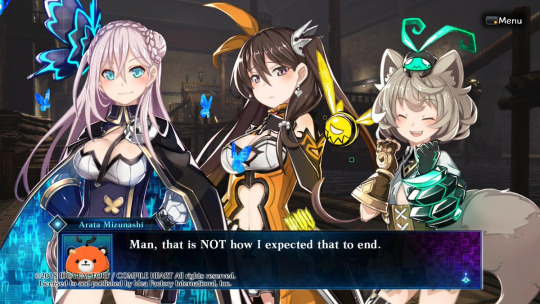
The game's amazing character designs, cool concepts, interesting battle mechanics, and (sometimes) catchy music can not save a game like this. It one that was bound to either be an A+ role-playing game or a game that completely squandered its potential to become a forgettable mess, and unfortunately Death End falls into the latter.
As someone who was actually fairly excited and interested in this game before it was released (though only getting to play it a few weeks after launch), it's unfortunate to me that this game was just mediocre at best.
1 note
·
View note
Text
Why You Should Play Chaos;Child [PlayStation Vita / PlayStation 4]
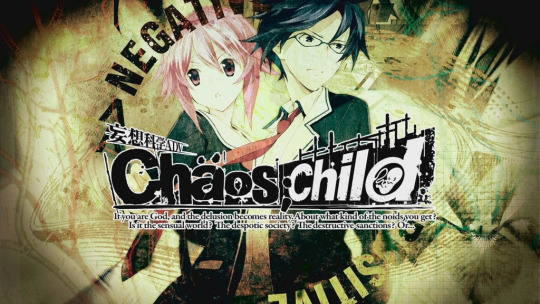
Chaos;Child is, in my opinion, one of the greatest stories ever written, though it has gotten far from the amount of attention it deserves. Please read through this and consider picking the game up! Don’t worry, there are no spoilers, though I should preface with saying that the game does feature some disturbingly-grotesque scenes, so this game probably isn’t for those of weak stomachs.
What is Chaos;Child about?
Chaos;Child’s story focuses around a high school student named Takuru Miyashiro, and his friends in the Newspaper Club at his school, Hekiho Academy. While the club is supposed to be responsible for reporting on the goings-on in and around the school, Miyashiro and [most of] his friends instead gain an interest in The Return of the New Generation Madness, a series of gruesome murders that emulate the original “New Generation Madness” (”NewGen”) from six years prior.
The students of the club - Takuru Miyashiro, his childhood friend Serika Onoe, his partner-in-crime Shinji Itou, the silent Hana Kazuki, and Miyashiro’s older sister Nono Kurusu - get wrapped up in the police investigation when Miyashiro and another club member are found at one of these murder sites, and the murders begin to follow the club around whether they like it or not.
Miyashiro wanting to uncover the Return of the New Generation Madness’ secrets leads them to learn about the psychic Gigalomaniacs that live among them, and have the ability to alter reality through the use of supernatural Di-Swords. Despite the fantastical approach to this story, Chaos;Child still takes a very scientific approach to explaining how these Gigalomaniacs and their powers exist.
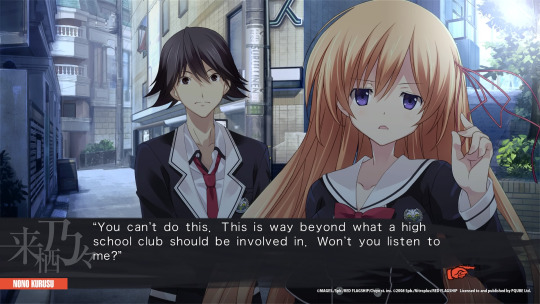
Does Chaos;Child have an anime series I can watch instead?
Chaos;Child does have an anime adaption... though I’d recommend you STAY CLEAR FROM IT. The anime does a terrible job at adapting the game’s story, as it rushes through the default route players are forced onto during their first playthrough but still incorporates elements from some of the other routes. This spoils a number of reveals that are done extremely-well in the game. An OVA of the game’s true ending has also been released, but as the main anime series is only 12 episodes and, again, cuts out most of the extremely well-written routes, makes the journey feel lackluster. If you really want to watch the anime series, I’d recommend doing so after you’ve played through the game.
What kind of game is Chaos;Child?
Chaos;Child is a murder mystery narrative video game that was released worldwide for the PlayStation Vita and PlayStation 4. The game was developed by 5pb., and serves as the fourth instalment of the Science Adventure franchise; most people are probably aware of Steins;Gate, and the Science Adventure (or SciADV) franchise is the universe in which that story, and several others, are set. Chaos;Child is technically the sequel to the first SciADV title, Chaos;Head, though Chaos;Child can be experienced with no knowledge of Chaos;Head or any other SciADV title.
Much like the other games in the Science Adventure series though, the game does a poor job of explaining how choices are made. Unlike most visual novels have the player make decisions via how they interact with the other characters, Chaos;Child instead has the player choose between a “Good” and “Bad” delusion via tilting the control stick left or right at specific moments; the player also has the option of ignoring these “Delusion Triggers”, which is necessary to achieve certain routes. The first time you go through the game’s story you are forced down a neutral route, but subsequent playthroughs centre have the player’s choice of delusion have repercussions that decide which of the different routes the player will go down. I’d recommend following a guide once you’ve played through the game once, as it can be difficult to discern which delusions have what consequences.
Though the visual novel genre is often scrutinized by mainstream audiences due to the most well-known examples being romantic games filled with fanservice and lewd scenes, Chaos;Child only has a literal handful of scenes with any explicit fanservice, though they do a fine job of giving a reason for them being there. The story of Chaos;Child is determined by the player choosing which “delusion” the main protagonist, Takuru Miyashiro, experiences. As he is a teenage boy, it’s not unusual to think that he would have some perverted thoughts about the girls in his life; these delusions are where all of the fanservice appears, though even then they’re spread very far apart.
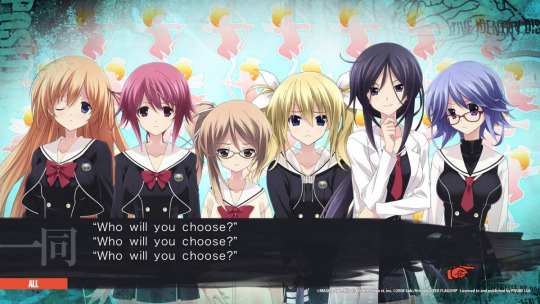
Before we get too far in, how does this story compare to Steins;Gate?
The common consensus between Science Adventure series fans (at least, those that I have seen) is that Chaos;Child tells a superior story to Steins;Gate. I’m not only inclined to agree with that, but I’d even go so far as to say that Chaos;Child is superior to Steins;Gate in literally every way.
How is Chaos;Child connected to Steins;Gate and the other SciADV games?
As previously mentioned, all games within the Science Adventure series take place within the same universe - though more specifically, the same multiverse due to Steins;Gate’s heavy use of time travel and thus the introduction and exploration of a large number of “worldlines”. The events of Steins;Gate begin in the same worldline that the Science Adventure series’ first instalment, Chaos;Head, occurred in, while all other main entries into the Science Adventure series occur in the worldline that is reached in the true ending on Steins;Gate: 1.048596%. Chaos;Child, as well as the series’ third instalment Robotics;Notes, thus only technically occur in-universe due to Rintaro Okabe’s actions in Steins;Gate (and Steins;Gate 0).
Chronologically, Chaos;Child takes place in 2015, six years after Chaos;Head. The actions that lead up to the finale of Chaos;Head cause a large artificial earthquake to heavily damage Shibuya. Chaos;Child is set in the same area, which has almost-completely recovered from the damage this earthquake caused.
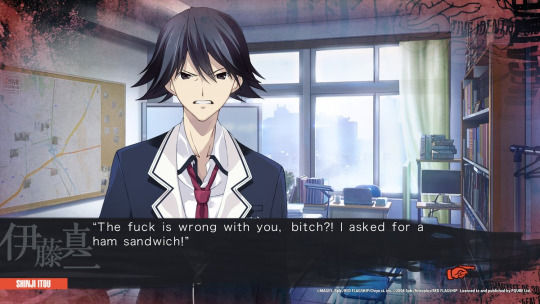
Do I have to know anything about the other SciADV titles to play Chaos;Child?
Not particularly. Being a thematic sequel to Chaos;Head, Chaos;Child references the events of this game far more than any of the other titles, though knowledge of that game isn’t really needed.
The events surrounding the original New Generation Madness series of murders are told through Chaos;Head, and while their existence in Chaos;Child’s story is important, they focus more on the official stories released by the police instead of the behind-the-scenes action the player of Chaos;Head experiences through the eyes of Takumi Nishijou. Besides the NewGen murders, only one character from Chaos;Head reappears in Chaos;Child, and some events told in the former are referenced more-often leading up to the story’s climax. Unfortunately, Chaos;Head hasn’t received an official English release (and as far as I know, the best fan translation is no longer being worked on), so even if it was truly important to the story, it would be difficult to play through it.
For those with knowledge of Steins;Gate or Robotics;Notes (or even Chaos;Head), there are smaller references to remind players that all of these stories exist in the same universe. Gunvarrel, the giant robot of justice which Robotics;Notes focuses around, is referenced during the obligatory school festival part of the story. There are also some indirect references to Makise Kurisu and Itaru Hashida by one of the story’s main characters, and a spin-off story (which hasn’t been localized) even tells of this character’s relationship with Kurisu.

Where can I buy this game?
The game is available digitally on the PlayStation store in Europe and North America. I believe PQube, who released the English version, also released the game physically in Europe and through online retailers for the Americas.
#steins;gate#steins gate#steins gate 0#steins;gate 0#makise kurisu#makise#kurisu makise#okabe rintarou#okabe rintaro#okarin#okabe#rintaro okabe#rintarou okabe#chaos head#chaos;head#chaos;child#sciadv#science adventure series#science adventure#sciadv series#takumi nishijou#nishijou takumi#nishijou#takuru miyashiro#miyashiro takuru#miyashiro#serika onoe#onoe#onoe serika#playstation
45 notes
·
View notes
Text
Fire Emblem Warriors [Nintendo Switch] - Review
Fire Emblem Warriors is the latest entry into Koei Tecmo’s Warriors series of hack-and-slash video games. Based upon Nintendo’s Fire Emblem franchise, Fire Emblem Warriors combines the tactical elements and characters of the Fire Emblem series, with the general gameplay of the Warriors series. The game follows 2014′s Hyrule Warriors as the second collaboration title between a Nintendo franchise and Koei Tecmo’s Warriors; with the 2014 title featuring characters from The Legend of Zelda series. Many gameplay elements from that game are present in Fire Emblem Warriors, though both games are different enough that one may like one, but not the other; they are, however, also similar enough that it would be very easy to compare them to one another, which many have done and will continue to do.
The plot of Fire Emblem Warriors is a rather simple one: an ancient beast known as the Chaos Dragon has been reawakened after thousands of years, and the main characters - a pair of twins and the prince and princess of Aytolis, Rowan and Lianna - have to use the Fire Emblem (which, in this game, is known as the Shield of Flames) in order to seal it away once more. Characters from other Fire Emblem titles - most notably Fire Emblem: Shadow Dragon, Awakening, and Fates - also appear in the game as playable warriors, with their appearances being the work of Outrealm Gates created by the Chaos Dragon as it awakens.
While the Warriors series has never been especially known for its stories, it is hard to deny that the plot of Fire Emblem Warriors is especially lazy. Hyrule Warriors features a similar premise, though as the Zelda series all takes place within one world over many millennia (unlike Fire Emblem, in which many games take place within their own worlds and are not linked to each other), they use the idea of time being distorted in order to explain the appearances of heroes from multiple different games. In addition, the 2017 title Warriors All-Stars, which features characters from several different IPs owned by Koei Tecmo, similarly focuses around a number of different characters being taken from their worlds in order to save the one that the main protagonists reside in. Both of the aforementioned titles however make these plots more interesting by using characters created specifically for these crossover titles - namely Lana and Cia for Hyrule Warriors and Tamaki, Shiki, and Setsuna for Warriors All-Stars. Fire Emblem Warriors features the royal twin stars of the game - the aforementioned Rowan and Lianna - as well as the prince of the neighbouring kingdom of Gristonne, Darios (who, despite being present throughout the entire game, can not be played as). Unlike the characters of other titles however, Rowan and Lianna don’t really have anything to make them interesting and do not stand out at all among the other characters of the game. Lianna is described as a more studious woman, and her brother is more excitable, wanting to forego becoming king in order to become a knight instead. These are all of the characteristics of the characters; they barely even stand out among the protagonists of other RPG series.
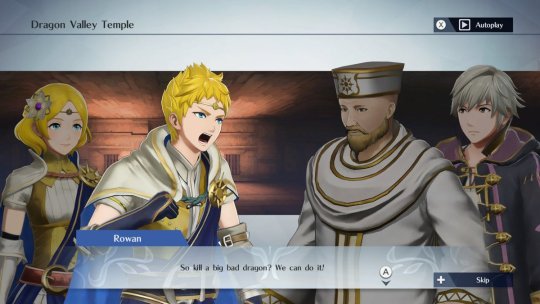
Fire Emblem Warriors features a total of 23 different characters to play as; with an additional 2 characters being genderswapped versions of the avatar characters from Awakening and Fates. While an impressive number, very few characters have unique movesets - in fact. there are only 16 movesets. Without purchasing DLC, Hyrule Warriors for the Wii U featured 21 unique movesets - or, should one count characters included in free updates, 25 unique movesets; the port of the game for the New Nintendo 3DS, released in 2016, featured 37 unique movesets in the base game. Considering this, it isn’t hard to be just a little bit disappointed when you unlock a new character only to learn that you’ve already played their moveset before. One of my personal gripes when it comes to movesets are that a number of characters fight on horseback. Riding on horseback is a feature present in many Warriors games, but in most cases it’s optional; in Fire Emblem Warriors, some characters can only be played as while on horseback. While some may not see this as a problem, I personally find that playing as mounted units is a challenging endeavour, as they lack the precision that other characters have, and at times the camera will lag behind their quicker attack movements. While this normally wouldn’t be a problem, almost a third of the playable characters - 7 of the 23 - are mounted units, meaning that in most battles, you’ll have to deal with at least one being in your party.
Surprisingly enough, many of the Fire Emblem series’ gameplay elements mesh quite well with the Warriors hack-and-slash gameplay. Fire Emblem Warriors allows players to command their units using a tactical grid almost identical to the gameplay spaces of Fire Emblem titles, and players can also pair units up in order to have them attack together and increase their bonds. This whole idea is hindered however when you can’t necessarily choose who you bring into battle - even in Free Mode (and if you can, the game doesn’t make it clear; even after reading through the tutorials multiple times, I still can’t figure it out)!
Unfortunately, praise can not be handed out to all of the gameplay elements. Fire Emblem notably features a weapons triangle - units wielding certain weapons deal more damage against units wielding others. Fire Emblem Warriors takes this element, but the more frantic and fast-paced gameplay makes it harder to keep track of which enemies have what. Additionally, although I’m not sure whether I’m to blame or the game is, the orders given to units through the tactical grid are not always followed by the CPU units; one time I had ordered Hinoka (a Pegasus Knight weak to Archer units) to stay at the allied base and away from the target (an Archer), and yet somehow she ended up across the map and getting killed by them, meaning I can no longer use her in battle. Though not a huge loss, as I disliked playing as her anyway, it nevertheless made me extremely frustrated. This happened a few times to me, and I even considered switching from Classic Mode (units that are defeated remain unusable) to Casual Mode (units that are defeated come back in the next battle) out of frustration (though I did not).
In addition to the game’s story mode, the game also includes a “History Mode”. History Mode allows the player to revisit battles from previous Fire Emblem games, and complete new scenarios in order to advance through these events. This mode is comparable to Hyrule Warriors’ Adventure Mode, and players are even able to unlock certain characters by playing through this mode (namely female Robin, male Corrin, Lyn from The Blazing Blade, and Celica from Shadows of Valentia). Both the History Mode and story mode suffer from a common problem: they lack identity. Aside from the tactical map and weapons triangle, the game feels very... bland and devoid of character. While the gameplay does feel smoother than Hyrule Warriors, Warriors All-Stars also used the same fundamentals and built a game that feels more unique and interesting than the end result of Fire Emblem Warriors. Something that helps with this are the game’s stages - Hyrule Warriors and Warriors All-Stars feature many stages with unique designs inspired by the games represented, but Fire Emblem Warriors’ stages, at least from what I can tell, all seem to be generic areas created specifically for this game. While that could be good (other Warriors games often prove this to be true), the maps generally all follow similar design principles, meaning that they all blend together and do not feel unique; more, they feel like backdrops to a battle instead of the setting of a battle.
One other major criticism comes from Fire Emblem Warriors’ incredibly annoying voice samples and portrayals, with the English voices seeming more like a distraction than an actual part of the game. The original Japanese voices are also not in the game by default, and must be downloaded (thankfully they’re free).... though the frequency of the playing of certain voice lines is still incredibly annoying.
In certain ways, the game improves over Hyrule Warriors, but ultimately it falls flat when compared to it. The game’s lack of identity is its biggest flaw. I would personally recommend this game to fans of the more recent entries into the Fire Emblem series, though those that do not enjoy them, or the series as a whole, will likely not get as much out of this game. Fans of other Warriors titles may also want to try this game out, but I hesitate in saying that all fans of that series will enjoy it. I went into the game with low expectations, but I come out with very mixed feelings about wanting to go back to complete the game 100%.
#fire emblem#fire emblem awakening#fire emblem warriors#fire emblem: awakening#fire emblem fates#fire emblem: fates#fire emblem shadow dragon#fire emblem: shadow dragon#fe warriors#fe#marth#lucina#nintendo switch#new nintendo 3ds#3ds#nintendo#switch#nintendo 3ds
2 notes
·
View notes
Text
I made a new blog so I can post game/book/whatever reviews or rambles without deviating from my normal Danganronpa-centric content → @mirairambles
you don’t have to follow it. I’m just posting it just in case anyone is curious about my thoughts on stuff. Danganronpa-related rambles will continue to be on this blog, though.
1 note
·
View note